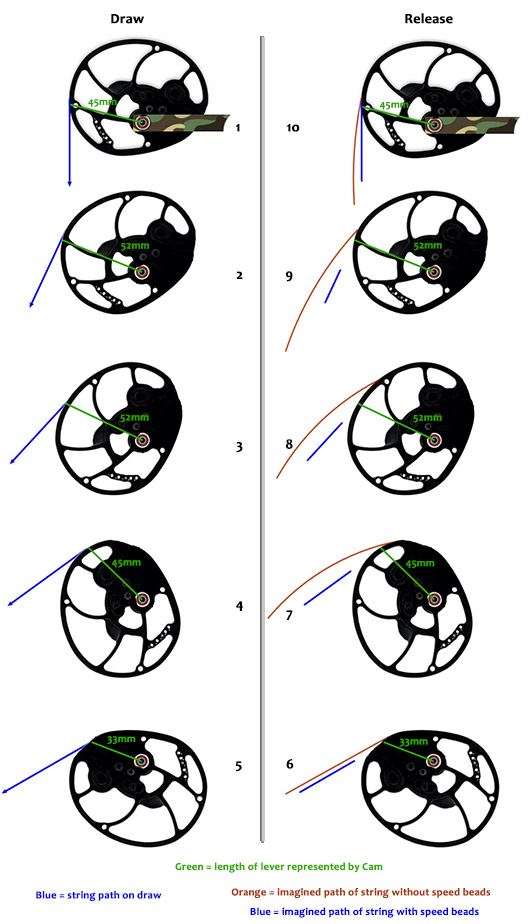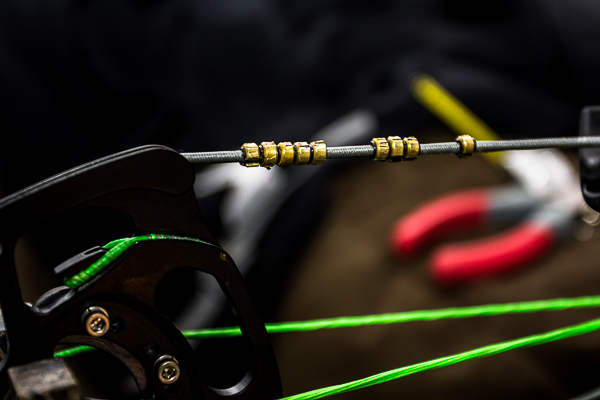Whilst I wait for my Bow to arrive, I've been watching the zillion uTubery films on Compound Bows. I now think I understand, pretty much everything, about the process of setting up and tuning and sighting in, a Bow and it's Arrows.
When I do it in person, it will be hours of fun, for weeks and more it seems.
The one thing I can't quite get, is the physics behind these speed beads or speed nocks, that people place on the Compound Bow string, typically, a group or two, a few cm away from where the string meets the Cam.
I've seen several blokes, who appear to know what they are talking about, take, before and after measurements, of the arrow speed through a chronograph and seemingly gaining a speed increase of up to 10 fps.
I first thought, that if the bloke had drawn his bow string another cm or two, he could get a faster arrow, and I was prepared to disbelieve.
Then I started noticing that the flagship Bows, from top name manufacturers, came with these speed beads pre-installed.
Then I tried to see , from a physics point of view, what effect these beads may have. The 1st and obvious conclusion would be, that they add weight to the string and thereto, slow the string ever so slightly. Ergo, slower arrow.
But then I wondered about harmonics. Then I thought, that the extra inertia, that has to be overcome on arrow release, should really slow things down.
I can't really see any argument, one way or the other, that is sensible for speed beads, the harmonic idea may have legs, thinking of music, and how a string has standing harmonic wave forms, at certain points.
This is complicated, by thinking :: at full draw, a bow string is effectively two anchored strings, Cam to D Loop and D Loop to Cam. When the arrow is released, these two strings become shorter and shorter until the arrow de-nocks and then it's one string again.
High speed video footage I've seen, shows the string behaving more or less as two straight strings, until the arrow nears de-nocking, at which point the string dances about like limp spaghetti at a disco.
So, I'm going to ask a friend of mine who can think in the language of Physics, what he thinks. And I ask here in this forum, what do you guys/gals think? Has anyone had practical experience of these speed beads? does anyone know the Physics to do with this?
I can't help thinking that, like having the right logo, on the running shoes of an athlete, it may well be that speed beads, make the Archer feel better and thereto shoot better. But I'd like to know definitively.
This'll keep me occupied for months.
This chap seems to be someone who does things correctly, his reviews often involve spread sheets and multiple tests, and proper statistical analysis.
https://youtu.be/HrUwQnmQC1I
an article:
https://www.bowhunting.com/blog/2013...ase-bow-speed/
How to measure arrow speed without a chronograph
https://youtu.be/tazuavGL6g8
Welcome guest, is this your first visit? Create Account now to join.
Welcome to the NZ Hunting and Shooting Forums.
Search Forums
User Tag List
+ Reply to Thread
Results 1 to 5 of 5
-
14-05-2020, 09:43 AM #1
 Speed Beads/Nocks - Placebo effect or true?
Speed Beads/Nocks - Placebo effect or true?
-
-
14-05-2020, 10:21 AM #2
Some interesting threads -
https://www.archerytalk.com/vb/showt...php?t=4628553&
My experience with the speed beads - TexasBowhunter.com Community Discussion Forums
Podcast 1:36:30, said to be informative, but time I might not get back.
Bowjunky archery podcast: Bowjunky podcast ep 17
-
15-05-2020, 10:06 AM #3
good point, I'm obsessing because I want to find out if there's science in this or if its fashion.
It's ben pointed out elsewhere that the force from the bow, by far and away, overwhelms the inertia of the tiny little speed beads, so perhaps it is about how the string behaves, rather than the basic sums of weight, i.e. grains gr vs pounds lbFrom the physics point of view I'll go and WAG that the mass closer to the point of rotation /(moment of acceleration?) - will increase velocity coming up to/ camming over, the point of release, while retarding and negative acceleration (harmonic)
Oh yes, but like flower arranging, sometimes it's not OK, until that last little bud is arranged, just, so....Absolute non-bow-guy here but I'd think there's a lot of tuning to be done before this is even a consideration?Last edited by MarkN; 15-05-2020 at 10:13 AM.
-
16-05-2020, 05:10 PM #4
I think I have an answer that will at least, work for me.
Someone opined that the speed bead's inertia would make the string move into the Cam groove more quickly.
On imagining this, and watching a hundred or so "Slow Motion" Compound Bow uTubes, I came up with an idea.
If the string is being pulled by the Cam, the diameter of the Cam at the point where the string intersects it, is the effective lever. On an asymmetric Cam this lever varies in length as the Cam rotates. If we can apply the string to the Cam, slightly earlier compared to normal, we could get a speed advantage.
We can imagine, that without speed beads, the string when released at nock point and pulled by the Cam, will, because of it's own inertia, bow or bend, slightly away, from a direct line between nock point and Cam intersection.
With speed beads, which are closer, to the nock point, than the Cam, at full draw, the string conceivably, would bend more at the speed bead end, where there is more inertia, and "pull" the Cam end, straighter. resulting in the intersection with the Cam being more advanced in time, than without. So the Cam is effectively doing it's work with the string, ever so slightly quicker.
Someone in the links posted above, worked out using physics and maths that the "With Speed Bead" advantage would be something in the order of 2 ~ 2.6 %
Which tallies with the observed speed claims.
Please see the below picture, wot I made on the electric drawing television.
I hope that this will demonstrate what I'm on about.

Similar Threads
-
Crimping and it's effect on accuracy.
By 257weatherby in forum Reloading and BallisticsReplies: 12Last Post: 06-10-2018, 04:17 PM -
New skulls and beads arrived
By terryf in forum Knives 4 AfricaReplies: 0Last Post: 01-08-2018, 08:48 AM -
Dirty suppressor effect accuracy?
By Beetroot in forum Firearms, Optics and AccessoriesReplies: 8Last Post: 19-01-2016, 06:48 AM -
OAL effect on pressure and velocity
By Mossie in forum Reloading and BallisticsReplies: 3Last Post: 22-05-2014, 11:57 AM -
Effect of suppressor on performance of a given load...
By .22-250 everything in forum Firearms, Optics and AccessoriesReplies: 20Last Post: 11-07-2012, 05:51 PM
Tags for this Thread
Welcome to NZ Hunting and Shooting Forums! We see you're new here, or arn't logged in. Create an account, and Login for full access including our FREE BUY and SELL section Register NOW!!





 LinkBack URL
LinkBack URL About LinkBacks
About LinkBacks




 Reply With Quote
Reply With Quote



Bookmarks